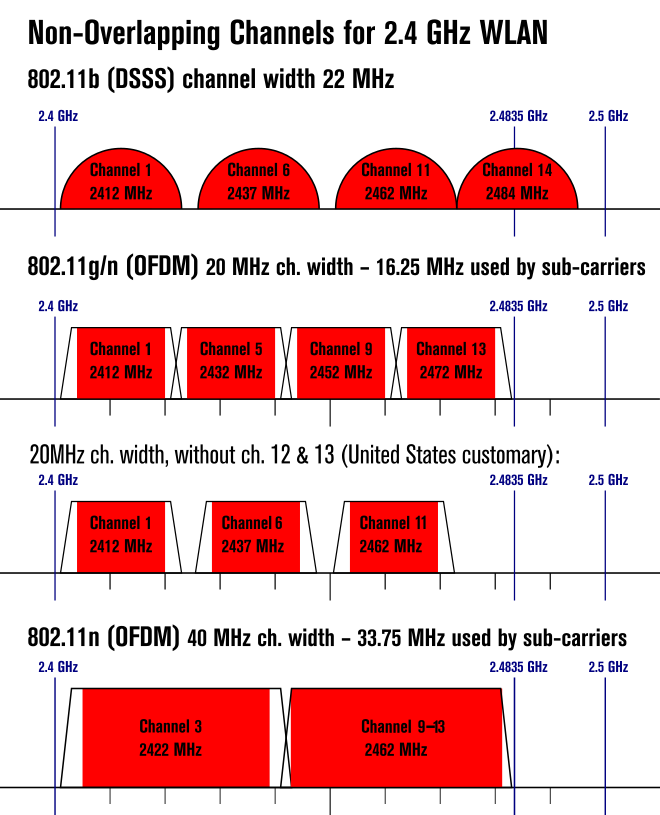Understanding FCC/ETSI, DFS regulations for 802.11ac deployments
UNDERSTANDING FCC/ETSI, DFS REGULATIONS FOR 802.11AC DEPLOYMENTS
Most people are familiar with 2.4 GHz band for Wi-Fi operation which provides 3 non-overlapping channels of 20 MHz resulting in total channel capacity of 60 MHz. Most interference in this band comes from microwave, Bluetooth and digital phones, which administrators are familiar with, are usually temporary in nature, and can be mitigated by appropriately moving the interfering device.
However, new Wi-Fi technologies like 802.11n and 802.11ac also uses 5 GHz band. This band provides up to 21 non-overlapping 20 MHz channel resulting in a total channel capacity of 420 MHz. In fact, the latest Wi-Fi standard, 802.11ac only operates in the 5GHz band with wave 1 radio chipsets capable of bonding 4 20MHz channels providing a channel width of up to 80 MHz for a single transmission with data rates of 1.3 Gbps. The wave 2 chipsets will be able to bond 8 20 MHz channel for a total channel width of 160 MHz for single transmission rate of 3.5 Gbps.
Before getting carried away with the higher data rates available with 802.11ac, it is important to understand the regulatory aspects for the 5GHz band.
Many of the frequencies in the 5 GHz band are also used by radar equipment for first responders, airports, weather stations and military installations. Because of this there are very stringent government regulatory requirements that must be followed by Wi-Fi radios when operating on these frequencies. The regulatory bodies specifying and enforcing these requirements in North America is the Federal Communications Commission (FCC) and in the European Union it is the European Telecommunications Standards Institutes (ETSI). Requirements/specifications for operating on the 5GHz band are called Dynamic Frequency Selection (DFS). DFS allows unlicensed devices to use the 5GHz band already allocated to radar systems without causing interference to those systems.
These DFS requirements are complex and costly to get regulatory certification from FCC/ETSI. Following are the typical requirements for access points (AP) operating on 5GHz DFS channel:
- Before starting operation on DFS channel, scan the channel for Radar devices for 1 minute. If radar is detected follow step 4 otherwise start operation of DFS channel.
- Must detect non-Wi-Fi Radar devices with pulse width as small as 5 us
- When radar device are detected stop operation on the channel within 500 milliseconds. For AP vendors, this also means informing wireless clients to move away from this channel.
- Do not become operational of this DFS channel for at least 30 minutes and after that go to step 1 before becoming operational again.
Given the above complexity many small office-home office vendors as well as some enterprise AP vendors don’t allow operation on DFS channels in the 5GHz band at all. Many client devices are also not certified for DFS band operation. Even when APs are certified and support DFS channels AP vendors often recommend operation exclusively on non-DFS channels given the uncertainty of DFS channels support at the client device level.
Given above complexities of operating on DFS channel, it is prudent to look at how many DFS and non-DFS channels are available in 5GHz band. Table below provides that break down.
| CHANNEL WIDTH | NO. OF channels in 5GHz band (including DFS CHANNELS)(FCC) | NO. OF Non-DFS CHANNELS (FCC) |
|---|---|---|
| 20MHZ | 24 | 9 |
| 40MHZ | 11 | 4 |
| 80MHZ | 5 | 2 |
| 160MHZ | 2 | 1 (disjoint) |
For IT administrators in medium to large enterprise, the above table should provide enough reason to really think above how they will deploy their wireless network in 5GHz band.
Following are some of the questions that should be thoroughly addressed:
- Should the deployment use DFS channels?
- What is RF coverage for devices not supporting DFS channels when APs are deployed on DFS channels? What percentage of my client devices support DFS channel? What is the migration plan?
- If DFS channels are used, what is the likelihood of network interruption due to radar event?
- How would the network behave when radar is detected by one or more APs? Will they stop operations or chose a different non-DFS channel of operation? How disruptive is this event to the network?
- Is there an option to operate exclusively on non-DFS channels? If so, what would the channel plan look like with only 2 non-DFS 80MHz channels available with wave 1 11ac APs?
Our recommendation is work with your AP vendor to answer these questions. Understand that moving from 2.4GHz band to 5GHz band would require 2 to 3 time more APs to provide the same coverage, it is law of physics. Additionally if the goal is to provide the highest possible 11ac rates everywhere, you would need to increase the AP density by another factor of 2-2.5. Consider this when budgeting for your next upgrade.


| Channel | Frequency (MHz) | North America [5] | Japan[5] | Most of world [5][6][7][8][9][10] |
|---|---|---|---|---|
| 1 | 2412 | Yes | Yes | YesD |
| 2 | 2417 | Yes | Yes | YesD |
| 3 | 2422 | Yes | Yes | YesD |
| 4 | 2427 | Yes | Yes | YesD |
| 5 | 2432 | Yes | Yes | Yes |
| 6 | 2437 | Yes | Yes | Yes |
| 7 | 2442 | Yes | Yes | Yes |
| 8 | 2447 | Yes | Yes | Yes |
| 9 | 2452 | Yes | Yes | Yes |
| 10 | 2457 | Yes | Yes | Yes |
| 11 | 2462 | Yes | Yes | Yes |
| 12 | 2467 | NoB | Yes | Yes |
| 13 | 2472 | NoB | Yes | Yes |
| 14 | 2484 | No | 11b onlyC | No |

留言